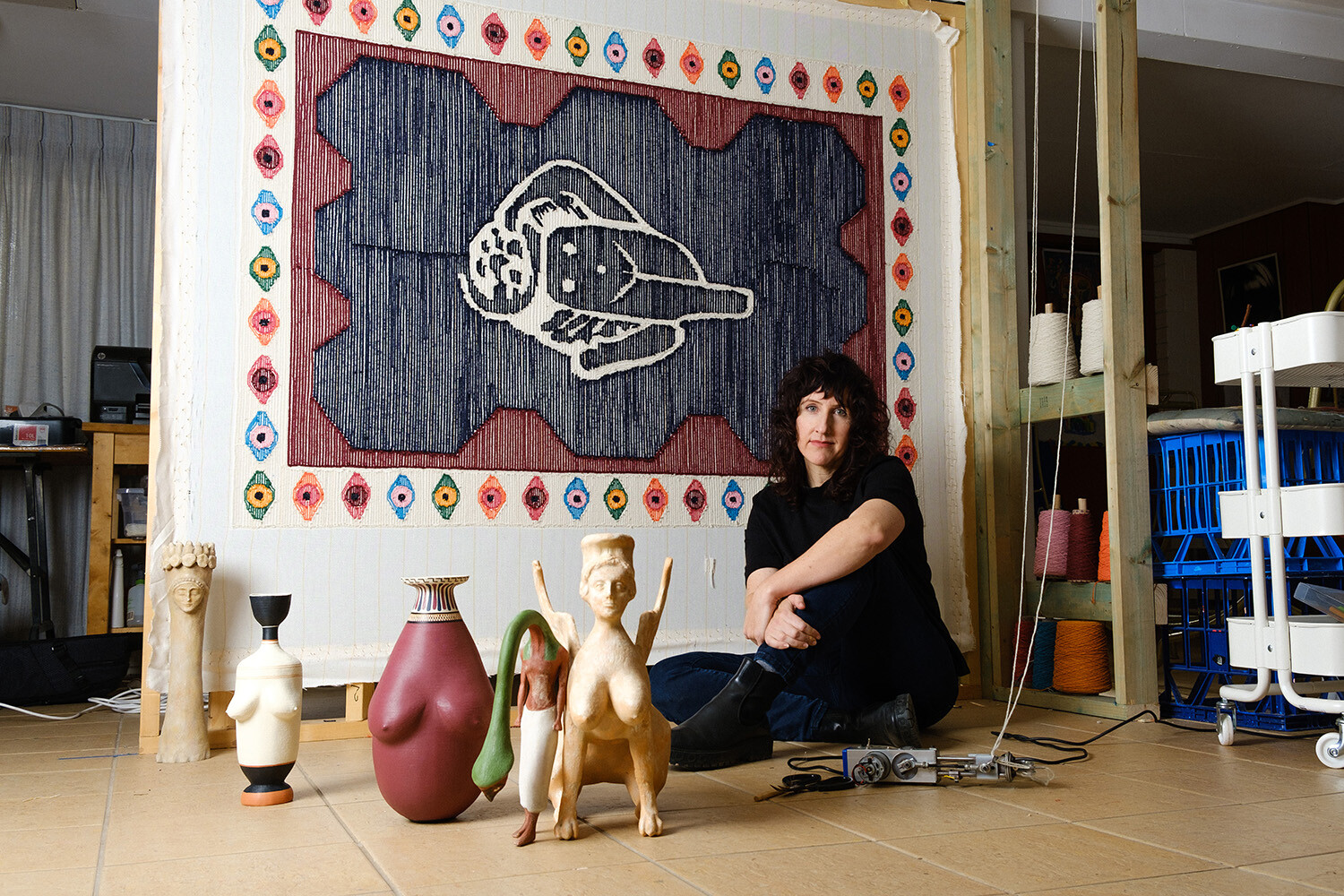The Interior
July 30–October 1, 2022
420 Brunswick Street
Fortitude Valley
Brisbane Queensland 4006
Australia
Hours: Tuesday–Saturday 10am–5pm
T +61 7 3252 5750
ima@ima.org.au
Can we use the talking cure to solve society’s “problem” with women?
Natalya Hughes’s The Interior invites audiences into an exaggerated consultation room playfully furnished for psychoanalysis. This immersive installation combines sculptural seating, richly patterned soft furnishings, and uncanny object d’art, nestled around a hand-painted mural to generate a stimulating space to unpack our collective and unconscious biases.
Interested in the role of women and their historical absence from positions of power, the part-professional part-domestic setting conjured by The Interior plays with gendered power dynamics between public and private space. The couches that dot the gallery take their lush contours from the shapes of the female body, and their detailed upholstery sees motifs of eyes, rats, and snakes from Freud’s patient case studies ripple over the space in fleshy tones.
Audiences are invited to recline and be enveloped, soothed, and held by the furniture’s womanly forms while taking turns playing analyst and patient. Throughout this bodily encounter The Interior hopes to create a space where the existence of women can be reimagined on different terms in the “post-Me Too” world.
Curated by Tulleah Pearce.
Publication
A publication accompanying the exhibition will be published in October, exploring three interrelated strands in the artist’s recent practice that that reappraise male modernists (Freud, Kirchner, and deKooning) and their complex female subjects.
Featuring essays by Dr Susan Best (Queensland College of Art, Griffith University), Dr Jacqueline Chlanda (University of Queensland Art Museum), Dr Andrew McNamara (Queensland University of Technology), alongside an interview between Hughes and curator Elspeth Pitt (National Gallery of Australia) this publication is a rich survey of Hughes’s recent work.
The Interior is designed by EviO Studio, Sydney and published by the Institute of Modern Art, Brisbane.
The artist
Natalya Hughes’s practice is concerned with decorative and ornamental traditions and their associations with the feminine, the body and excess. Recent bodies of work investigate the relationship between Modernist painters and their anonymous women subjects.
Hughes won the Sunshine Coast Art Prize in 2020 and was a finalist in both the Sulman Prize at Art Gallery of NSW and the National Works on Paper Prize at Mornington Peninsula Regional Gallery in 2018, as well as the 2017 Ramsay Art Prize at Art Gallery of South Australia. Her work has been included in institutional exhibitions such as Queensland Art Gallery|Gallery of Modern Art (2019, 2017 and 2012), Artspace Sydney (2016), Hazelhurst Regional Gallery (2015), Ian Potter Museum of Art, Melbourne (2009) and Tarrawarra Museum of Art, VIC (2006).
Hughes completed a Bachelor of Visual Arts at the Queensland University of Technology, Brisbane in 2001 and a PhD in Art Theory at the College of Fine Art (UNSW) in 2009. She currently lives in Brisbane and is the Honours Program Director, Visual Arts at the Queensland College of Art. She is represented by Milani Gallery (Brisbane) and Sullivan + Strumpf (Sydney).
About the Institute of Modern Art
Since 1975 the Institute of Modern Art has been the hub of Brisbane’s contemporary at scene, presenting an annual program of exhibitions, public programs, publications, and offsite programs by Queensland, Australian, and international artists. The IMA is a registered charity and membership organisation supported by the Queensland Government through Arts Queensland, the Australian Government through Australia Council for the Arts, and the Visual Arts and Craft Strategy, an initiative of the Australian Federal, State, and Territory Governments. The IMA is a foundng member of Contemporary Art Organsiations Australia.
Natalya Hughes is the 2022 recipient of the Michela & Adrian Fini Artist Fellowship, awarded by Sheila Foundation.
This project has been assisted by the Australian Government through the Australia Council, its arts funding and advisory body.
